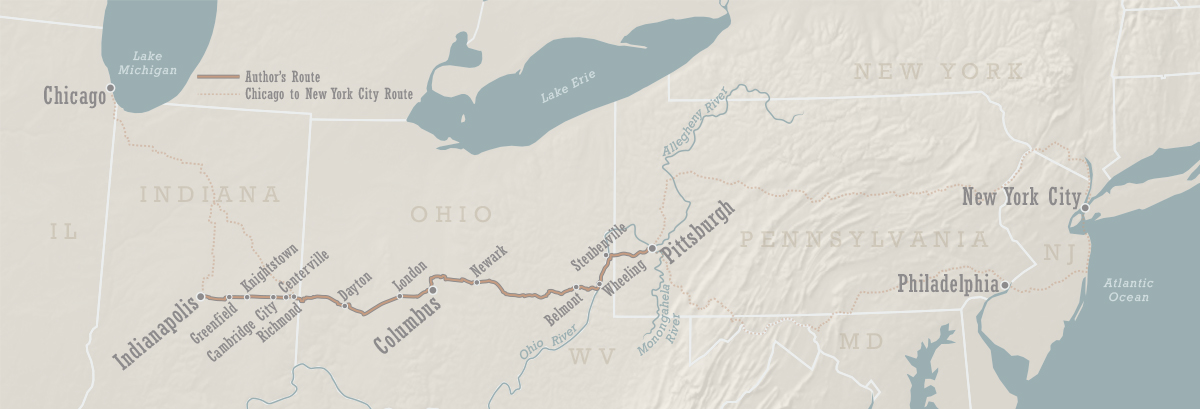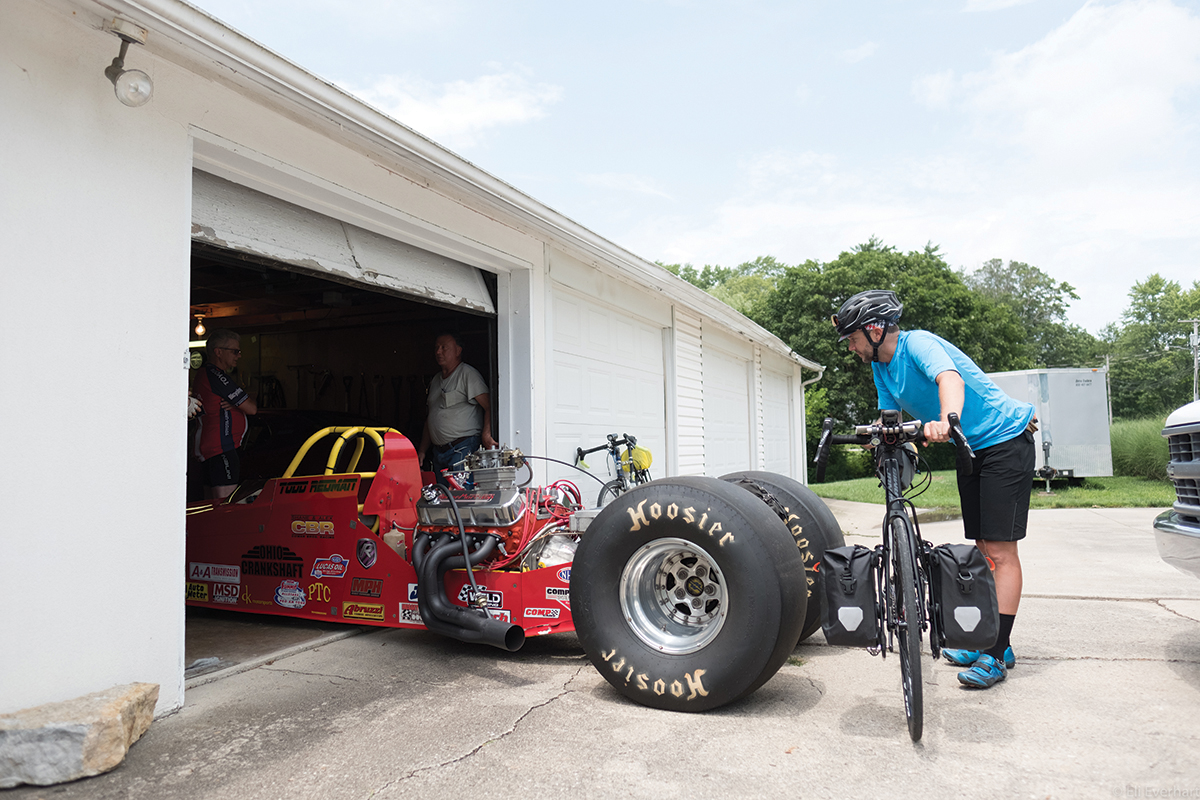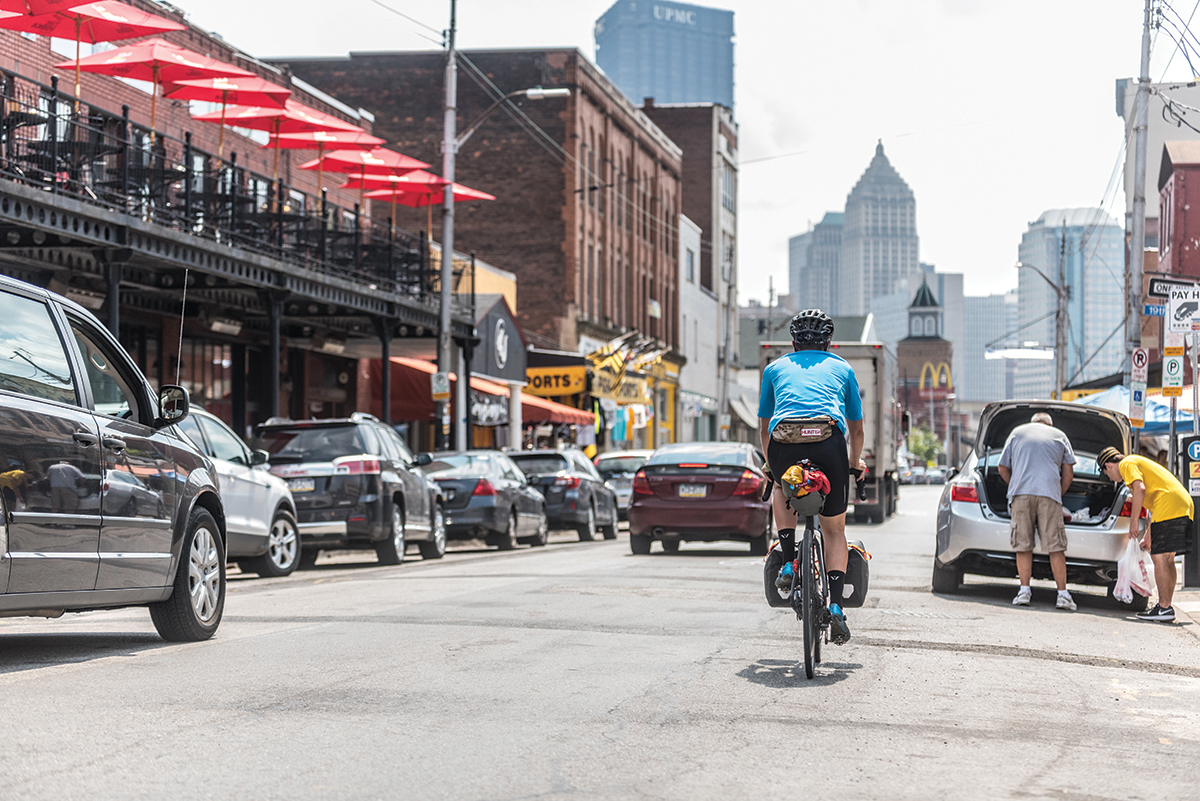Six Days on the Chicago to New York City Bicycle Route
You never know quite what to expect when leaving on a bicycle tour. Most of us plan for a wide variety of weather, terrain, mechanical issues, and more. But when I was packing for my tour along a section of the Adventure Cycling Association’s new Chicago to New York City Bicycle Route, I knew a few things were certain — it was going to be hot, and it was going to be humid. Had I known how humid, I might have left a few things at home.
On tap were 425 miles between Indianapolis, Indiana, and Pittsburgh, Pennsylvania, right in the middle of the 1,160-mile Chicago to New York route. Except for the first 65 miles, it was all new to me. Instead of planning meticulously, I decided to take it day to day, with a general idea of what I needed to make my flight home in seven days’ time.

Family Time
I’m from the Midwest so I took the opportunity to visit my family in central Indiana before I lit out for lands eastward. I get a huge kick out of playing with my two nephews, and the Legan clan always rallies for a couple of meals and plenty of laughter when I make my way home. Because of this, I started my ride from Greenfield, Indiana, just east of Indianapolis. That’s where my parents have lived since I was in college, and it’s right on the new route.
I grew up riding bicycles in Indiana and started to pile on the miles when I was 12 years old. Since then everyone in my family has ridden road bikes to some extent over the years. My brother Joe lives in Indianapolis working in the motorsports world, but he makes his way around town aboard a Surly Cross-Check. My dad too has a couple of bikes, including a Specialized Langster singlespeed (the U.K. themed model) and a Giant Revolt gravel bike. It dawned on me that while a couple days at home before going on tour would be great, wouldn’t it be even better if my brother and dad joined me?
It didn’t take much for my brother to agree to ride the first day with me. We would cover 65 miles, but it would only be a little over an hour’s drive from his home and thus an easy pickup afterwards. I had no worries about his abilities as he spends a good deal of time on his bike, even if most of his rides are short jaunts.
My dad, on the other hand, took a little convincing. But soon he was on board to at least start the day with us. We built in a safety net with the addition of my buddy Elisha. He would leapfrog us in his car, taking photos along the way. If Dad got tired, he could hop in the car for a spell.
A motley crew to be sure, we rolled off just after dawn on a muggy, mid-July morning. The going was easy thanks to some of the flattest roads in the country. U.S. 40 is the original national highway, and we were on it for much of the day east of Indianapolis.
In Knightstown we met up with Elisha and made our first stop of the day at the Hoosier Gym, where the 1986 classic Hoosiers was filmed. The caretaker gave us a great tour, even allowing us to shoot some hoops. My brother and I re-enacted several pivotal scenes, but without the gold basketball shorts it didn’t play too well.
Back on the road, the heat and some rain showers caught up with us just in time to duck into the No. 9 Grill in Cambridge City. Over cool drinks and tasty sandwiches, we planned our next steps. While we had planned to camp that night, the forecast didn’t look good so we booked a hotel in Richmond, Indiana, right on the Ohio border. This was about fun after all — no need for us to suffer unnecessarily.
The route left U.S. 40 in Centerville, a pretty town with buildings from the late 19th century. There we also stumbled upon a resident firing up a drag racing car. My dad and brother are motorheads without equal so we took a few minutes to chat up the owner and discuss his years of drag racing around the Midwest. We weren’t in a rush, and it gave their derrières a bit of respite before carrying on.

We finished in Richmond with Dad having pedaled more than half of the day’s miles, which was quite the accomplishment considering how infrequently he rides. Joe cruised through the day, easily pedaling to our destination. After checking into the hotel, we showered and headed to the old railroad depot district in town. We found a record shop and purchased a few LPs. A microbrewery in the area served up tasty beers and food. My mother drove out to meet us for dinner and collect my dad in the process.
The following morning we woke to fog. The plan was for my brother and Elisha to follow along in the car for the day’s first miles to get more photos, and they would then turn west and head home. Having left U.S. 40, the roads — many of which are part of U.S. Bicycle Route 50 — turned winding and a bit hilly.
Taking Flight
Crossing over Interstate 70, we stopped at a convenience store where I bought a snack and filled my bottles. After hugging Elisha and Joe goodbye, I headed toward the rising sun. Narrow roads wound through the countryside. A covered wooden bridge from the 19th century was worthy of a short stop, but I had a midday destination in mind and hoped to cover over 90 miles before dusk. To prepare for the day’s later stop, I began listening to David McCullough’s The Wright Brothers on my Bluetooth speaker.
A few hours later, I made my way into Dayton, Ohio, detouring around some flooded sections of bike path. I easily found the site of the Wright Cycle Company a few miles off route. This is where the brothers built and sold bicycles — a business that was profitable enough to entirely fund their experiments in aviation. The tour of the National Parks facility is worthwhile, highlighting the brothers’ use of cycling technology in their flyers. Across the street is also a tasty barbecue restaurant that serves up a mean mac ’n cheese.
Much of the day’s riding was on rail trails in between towns and bike paths in urban areas. They made for relaxing cycling, with gentle grades and no traffic. This route really is great for people looking to avoid interactions with cars. With few exceptions, the section I rode was a cyclist’s delight.
I stayed in the sleepy town of London, Ohio, that night. At the town’s trailhead to the Ohio to Erie Trail (also known as the Prairie Grass Trail), there is free camping with a restroom, electricity, and a picnic shelter. I chose to stay at Andrea’s Bed & Breakfast where hostel-style bunk rooms are $25 a night. I showered, enjoying the cool water, and walked to the center of town in search of dinner. The innkeeper recommended Ronetti’s Pizza, a local Italian joint opened in 1969, and it didn’t disappoint. I gobbled up the spaghetti meal after a long day in the saddle.
Rail Trail Heaven
On the morning of my Day 3, I decided to try for two more long days. This would make the last couple of days a bit shorter and get me to convenient stopping points each day. From London I headed east, again along the Ohio to Erie Trail. A pair of blue herons and a beaver greeted me that morning as I passed marshy lowland. A green tunnel shaded me from much of the day’s heat, but the humidity was still oppressive at times.
While I packed a tent, sleeping pad, sleeping bag liner, and an emergency blanket, I never camped. Yep, I took a pass on misery and got a hotel or hostel each night. With the high humidity and hot temperatures, I quickly realized that I would sleep far more comfortably indoors. It would also better allow me and my clothes to dry out overnight.
After passing through Columbus, Ohio, I made my way to Newark. Instead of going directly downtown to my hotel, I detoured to the Newark Earthworks. Technically in Heath, Ohio, the Native American mounds form “the largest set of geometric earthen enclosures in the world” according to the ohiohistory.org website. I visited the Great Circle Museum to learn more and was impressed to discover how complex the area’s earthen structures are. Built between 100 BC and 500 AD, the earthworks cover four square miles and were used for ceremonies of the Hopewell culture. The visit was a highlight of my trip.
Putting on the Climbing Legs
Later that night I went to bed with a full stomach and a smile on my face after 80 miles of pleasant riding. I slept in a bit the next morning and headed to the River Road Coffee House for breakfast before starting Day Four. This was perhaps my favorite day of riding. It started with a sighting of the World’s Largest Basket, a seven-story building that houses the corporate offices of the Longaberger Basket Company (look it up, you will not be disappointed).
East of Newark I was back on two-lane roads with short, steep rollers. Despite riding with luggage on my bike, the hills were an absolute blast. Lunch at a small country store included an iced tea, turkey sandwich, pickle, and a push-pop ice cream. More cold drinks and a candy bar got me rolling again. After 90 miles, I left the route at Belmont to grab a hotel along Interstate 70 in Morristown.
Looking for dinner at an interstate exit can be trying. Sure you’ll find food, but the options will likely be fast ones or of the national chain variety. A most wonderful exception was Schlepp’s, a local diner that served up an incredible meal of grilled cheese on homemade bread, mashed potatoes and gravy, an ice cold Pepsi, and some blueberry pie à la mode. The patrons were just as friendly as the wait staff. I chatted with a gentleman in his 80s who had been coming to Schlepp’s for over 20 years.
From Midwest to East
With only 55 miles scheduled for Day Five, I slept in after a leisurely night of reading and television. The day started like the one previous had ended, with rolling hills and mostly quiet two-lane roads. After a short while though, the number of pickup trucks increased. All the drivers were perfectly polite though, giving me a wide berth.
At one point I stopped for a snack at a Family Dollar. While sitting in the shade, the lady working the checkout came out for a smoke break and I relished some conversation after a few days alone. The local economy came up and she mentioned that the recent increase in the oil and gas extraction business was a double-edged sword, infusing money into the community but also bringing a lot of outside labor. The trucks that had passed me were out servicing wells. Unfortunately, many of the down-and-out locals were still down and out.
Shortly after this stop, I experienced an abrupt transition from gorgeous country roads to an urban setting. I had dropped into the Ohio River Valley — industry took over from agriculture. Crossing the Ohio River in Wheeling, West Virginia, you cycle over the impressive Wheeling Suspension Bridge, the world’s largest for three years in the mid-19th century.
I’ll be honest about this next section along the Ohio River: it’s not great. There are plenty of bike path miles, and that’s nice, but I also rode a short distance on a couple of busy highways. I stayed the night in Steubenville, Ohio, a town that has seen better days.
The sixth and final day of my tour was a short one at only 45 miles. I backtracked a short distance to the route (Steubenville is a few miles off route) but shortened my time on Highway 2 after scouring Google Maps. The climb out of the valley was stout, but once on top, pleasant riding ensued.
Soon I joined the Panhandle Trail, another highlight. It includes some gravel sections that brought a sense of adventure without really adding any appreciable risk. It’s along the Panhandle that you cross from West Virginia into Pennsylvania. There is a small marker and a picnic table that signals the border. I caught up to and rode with a man in his late 50s who was using a part of the route to ride from his home in Ohio to Washington, DC. We rode together for an hour and got to know each other amazingly well in a very short time.
Steel City
The final miles on better-than-expected roads into Pittsburgh were fun, although there are some tricky turns. I thought it best to stop and double check the map on a couple of occasions. Soon though I found myself at Point State Park, the spot where the Monongahela and Allegheny rivers join to become the Ohio. It’s also the starting point of the Great Allegheny Passage trail. A local friend took me on a short tour including the Andy Warhol Museum and Warhola Recycling. (Andy Warhol’s given name is Warhola. This is a family member’s business and makes for great jokes regarding the soup can series.)
In the course of 400 miles I had transitioned from Midwest to East and from catching up with family in Indiana to seeing old friends in Pittsburgh. Chicago to New York may connect more urban areas than any other Adventure Cycling route, but in between the cities, I met wonderful people as I rode through landscapes as rural and bucolic as anywhere in America.

Nick Legan is the Technical Editor of Adventure Cyclist magazine, and he won’t tell us if he made any underhand free throws in the Hoosiers gym.
Nuts & Bolts Chicago to New York
Information
The Adventure Cycling Association developed the Chicago to New York City Bicycle Route, and its maps and digital GPX files work especially well in conjunction with one another. I carried the paper maps, putting them on my handlebars using Cue Clips. I also used a Garmin eTrex 30 to help me stay on track. I uploaded the digital files from Adventure Cycling onto RideWithGPS so that I could add in points of interest like museums, notable restaurants, campgrounds, etc. The new route is also available as a free smartphone app from the iTunes and Google Play stores (each map section is available for purchase via the app).
Accommodations
Camping is available along the route and marked on the maps. In most cases, these are commercial campgrounds a few miles off route. You’ll likely share them with RVs. The route frequently hits towns of reasonable size so hotels and motels are easily found — just do a bit of planning before you head out.
Gear
I rode a carbon fiber gravel bike (my review of the Jamis Renegade will be in the December/January issue) with 30mm tires, but the gravel sections are composed of finely crushed limestone and are easily handled by road bikes. Although there is little traffic, I still installed front and rear blinking lights. I carried both a cycling cap and a sweatband and swapped them out as one became saturated. I would strap one to the top of my pannier to dry in the sun.
Travel
Bike Flights was especially useful when it came to transporting my bike. I packed it in a cardboard box and sent it to my family’s home. For the return, I contacted a friend in Pittsburgh who nabbed a box for me. Similarly, you can ship to bike shops and pay them to pack your bike.
This story originally appeared in the October/November 2017 issue of Adventure Cyclist magazine.

